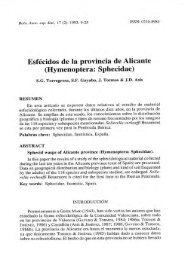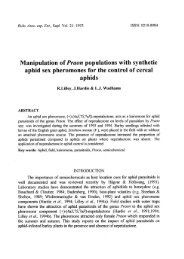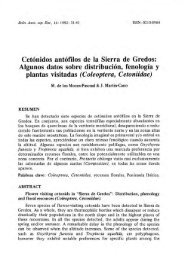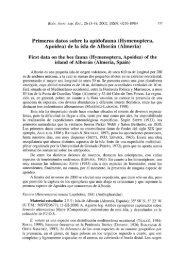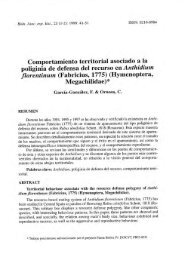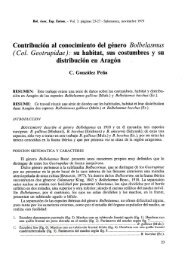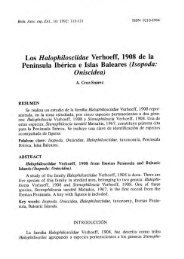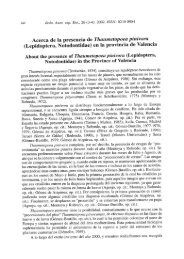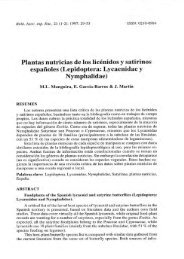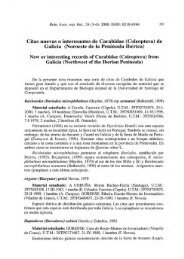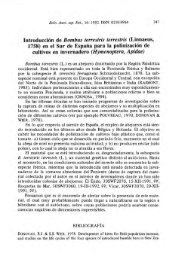Libro 1.indb
Libro 1.indb
Libro 1.indb
You also want an ePaper? Increase the reach of your titles
YUMPU automatically turns print PDFs into web optimized ePapers that Google loves.
GALL MIDGES (DIPTERA: CECIDOMYIIDAE) OF THE IBERIAN PENINSULA 117<br />
Kiefferia pericarpiicola (Bremi, 1847)<br />
Asphondylia pimpinellae F. Löw, 1877<br />
Larvae change in galls the fruits of Foeniculum officinale All., Laserpitium prutenicum L.,<br />
Petroselinum crispum (Mill.) Fuss (= P. sativum Hffm.), Physospermum cornubiense (L.)<br />
DC. (= P. aquilegiaefolium Koch) (Apiaceae). Occurrence: medium frequent (Fig. 83). References:<br />
TAVARES (1902a, 1905a, 1907a, 1909, 1914), VILARRÚBIA (1936). Distribution:<br />
Euro-Siberian.<br />
Kochiomyia kochiae (Kieffer, 1909)<br />
Rhopalomyia? Koehliae Kieffer, 1909<br />
Larvae cause globular, wooly galls of the size of a pea, at tips of shoots on Bassia prostrata<br />
(L.) Beck in Rchb. (= Kochia prostrata L.) (Chenopodiaceae). In one gall many larvae develop.<br />
Occurrence: very scarce (Fig. 84). References: HOUARD (1906, 1908-1909). Distribution:<br />
European, Pontic-Pannonian.<br />
Lasioptera ariasis Skuhravá & Garcia (in litt.)<br />
Larvae develops and cause damage to fruits of cherries Prunus cerasus L. cultivar ´Picotas´<br />
(Rosaceae). Occurrence: very scarce (Fig. 84); Valle del Jerte in the Province of Cáceres in<br />
Spain in 1995, leg. García (SKUHRAVÁ & GARCÍA, in prep.) Distribution: Mediterranean,<br />
endemic to the Iberian Peninsula.<br />
Lasioptera berlesiana Paoli, 1907<br />
Lasioptera kiefferiana Del Guercio, 1910<br />
Larvae are associated with olive fly (Bactrocera oleae) (Diptera: Tephritidae) on Olea europaea<br />
L. (Oleaceae). Occurrence: very scarce (Fig. 85). References: COGOLLUDO (1921),<br />
TAVARES (1924). Distribution: Mediterranean.<br />
Lasioptera carophila F. Löw, 1874<br />
Larvae cause rounded swellings at the base of primary or secondary umbels on Carum carvi<br />
L., Daucus carota L., Foeniculum officinale All., Bupleurum fruticescens L. and Margotia<br />
gummifera Lge. (Apiaceae). Each gall contains a chamber with one orange-red larva. Occurrence:<br />
frequent (Fig. 85); Matadepera (Barcelona, 1984-2003, new finding), Valls (Tarragona,<br />
2002, new finding), Tàrrega (Lleida, 2001, new finding), Lorca (Murcia, 1996,<br />
new finding), Aracena (Huelva, 1996, new finding). References: TROTTER (1899, 1900),<br />
TAVARES (1902a, 1905a, 1907a), COGOLLUDO (1921), VILARRÚBIA (1936), BELLIDO<br />
et al. (2003). Distribution: European.<br />
Lasioptera eryngii (Vallot, 1829)<br />
Larvae produce swellings of stems on Eryngium campestre L. (Apiaceae). Each swelling<br />
contains many chambers. Occurrence: medium frequent (Fig. 86); El Mascà (Tarragona,<br />
1982, new finding), leg. Pere Luque, and Sant Julià de Lòria and Santa Coloma (Andorra,<br />
1995), leg. J. Pujade-Villar. References: COGOLLUDO (1921), TAVARES (1931), VILAR-<br />
RÚBIA (1936), SKUHRAVÁ et al. (1996), BELLIDO et al (2003). In SKUHRAVÁ et al.<br />
(1996), the asterisk mark was erroneusly placed to the following species. Distribution: sub-<br />
Mediterranean.<br />
Lasioptera populnea Wachtl, 1883<br />
Larvae live as inquilines in galls of Contarinia populi (Rübs.) on leaves of Populus tremula<br />
L. (Salicaceae). Occurrence: very scarce (Fig. 86). Reference: COGOLLUDO (1921). This<br />
Boln. Asoc. esp. Ent., 30 (1-2): 93-159, 2006



